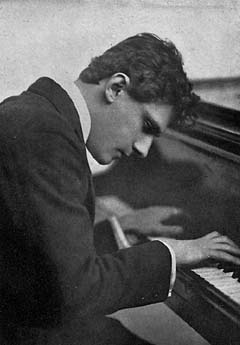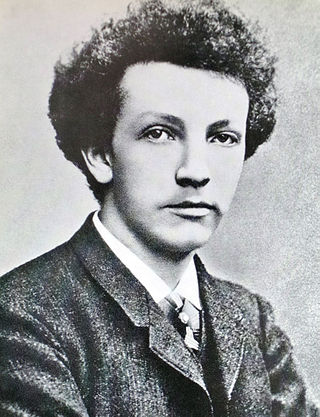Related Research Articles

Modernism is a philosophical, religious, and arts movement that arose from broad transformations in Western society during the late 19th and early 20th centuries. The movement reflected a desire for the creation of new forms of art, philosophy, and social organization which reflected the newly emerging industrial world, including features such as urbanization, architecture, new technologies, and war. Artists attempted to depart from traditional forms of art, which they considered outdated or obsolete. The poet Ezra Pound's 1934 injunction to "Make it New" was the touchstone of the movement's approach.
Postmodern music is music in the art music tradition produced in the postmodern era. It also describes any music that follows aesthetical and philosophical trends of postmodernism. As an aesthetic movement it was formed partly in reaction to modernism but is not primarily defined as oppositional to modernist music. Postmodernists question the tight definitions and categories of academic disciplines, which they regard simply as the remnants of modernity.

Postmodern art is a body of art movements that sought to contradict some aspects of modernism or some aspects that emerged or developed in its aftermath. In general, movements such as intermedia, installation art, conceptual art and multimedia, particularly involving video are described as postmodern.

Leo Ornstein was an American experimental composer and pianist of the early twentieth century. His performances of works by avant-garde composers and his own innovative and even shocking pieces made him a cause célèbre on both sides of the Atlantic. The bulk of his experimental works were written for piano.
20th-century classical music is art music that was written between the years 1901 and 2000, inclusive. Musical style diverged during the 20th century as it never had previously, so this century was without a dominant style. Modernism, impressionism, and post-romanticism can all be traced to the decades before the turn of the 20th century, but can be included because they evolved beyond the musical boundaries of the 19th-century styles that were part of the earlier common practice period. Neoclassicism and expressionism came mostly after 1900. Minimalism started much later in the century and can be seen as a change from the modern to postmodern era, although some date postmodernism from as early as about 1930. Aleatory, atonality, serialism, musique concrète, electronic music, and concept music were all developed during the century. Jazz and ethnic folk music became important influences on many composers during this century.
New musicology is a wide body of musicology since the 1980s with a focus upon the cultural study, aesthetics, criticism, and hermeneutics of music. It began in part a reaction against the traditional positivist musicology—focused on primary research—of the early 20th century and postwar era. Many of the procedures of new musicology are considered standard, although the name more often refers to the historical turn rather than to any single set of ideas or principles. Indeed, although it was notably influenced by feminism, gender studies, queer theory, postcolonial studies, and critical theory, new musicology has primarily been characterized by a wide-ranging eclecticism.
Postmodern dance is a 20th century concert dance form that came into popularity in the early 1960s. While the term "postmodern" took on a different meaning when used to describe dance, the dance form did take inspiration from the ideologies of the wider postmodern movement, which "sought to deflate what it saw as overly pretentious and ultimately self-serving modernist views of art and the artist" and was, more generally, a departure from modernist ideals. Lacking stylistic homogeny, Postmodern dance was discerned mainly by its anti-modern dance sentiments rather than by its dance style. The dance form was a reaction to the compositional and presentational constraints of the preceding generation of modern dance, hailing the use of everyday movement as valid performance art and advocating for unconventional methods of dance composition.

In music, modernism is an aesthetic stance underlying the period of change and development in musical language that occurred around the turn of the 20th century, a period of diverse reactions in challenging and reinterpreting older categories of music, innovations that led to new ways of organizing and approaching harmonic, melodic, sonic, and rhythmic aspects of music, and changes in aesthetic worldviews in close relation to the larger identifiable period of modernism in the arts of the time. The operative word most associated with it is "innovation". Its leading feature is a "linguistic plurality", which is to say that no one music genre ever assumed a dominant position.
Inherent within musical modernism is the conviction that music is not a static phenomenon defined by timeless truths and classical principles, but rather something which is intrinsically historical and developmental. While belief in musical progress or in the principle of innovation is not new or unique to modernism, such values are particularly important within modernist aesthetic stances.
Neoromanticism in music is a return to the emotional expression associated with nineteenth-century Romanticism. It is part of the wider movement of neo-romanticism.

Postmodern architecture is a style or movement which emerged in the late 1950s as a reaction against the austerity, formality, and lack of variety of modern architecture, particularly in the international style advocated by Philip Johnson and Henry-Russell Hitchcock. The movement was introduced by the architect and urban planner Denise Scott Brown and architectural theorist Robert Venturi in their 1972 book Learning from Las Vegas. The style flourished from the 1980s through the 1990s, particularly in the work of Scott Brown & Venturi, Philip Johnson, Charles Moore and Michael Graves. In the late 1990s, it divided into a multitude of new tendencies, including high-tech architecture, neo-futurism, new classical architecture, and deconstructivism. However, some buildings built after this period are still considered postmodern.
Les Apaches was a group of musicians, writers and artists which formed in Paris, France in 1903. The core was formed by the French composer Maurice Ravel, the Spanish pianist Ricardo Viñes and the writer and critic Michel-Dimitri Calvocoressi. The group was private but never formal, and the wider membership was fluid; over 20 unofficial members would attend meetings of Les Apaches until it came to an end during World War I. During their active years, Les Apaches met weekly. The meetings were a chance for the members to perform and show new works or ideas to a small group, discuss contemporary artistic interests and collaborate.
Daniel Albright was the Ernest Bernbaum Professor of Literature at Harvard and the editor of Modernism and Music: An Anthology of Sources. He was born and grew up in Chicago, Illinois and completed his undergraduate studies on a full scholarship at Rice in 1967. He received his MPhil in 1969 and PhD in 1970, both from Yale. Albright is also the author of the book Quantum Poetics which was published by Cambridge University Press in 1997. He held an NEH fellowship from 1973 to 1974, was a Guggenheim Fellow from 1976 to 1977, and more recently, he was a 2012 Berlin Prize Fellow at the American Academy in Berlin.
The Domaine musical was a concert society established by Pierre Boulez in Paris, which was active from 1954 to 1973. Composers represented at its concerts included Boulez, Karlheinz Stockhausen, Olivier Messiaen, Luciano Berio, John Cage, Sylvano Bussotti, Mauricio Kagel, Hans Werner Henze, Henri Pousseur, Ernst Krenek, Gilbert Amy, Peter Schat and Gilles Tremblay, Betsy Jolas as well as earlier composers considered part of the Modernist movement in music. Its regular performers included the pianists Claude Helffer, Paul Jacobs, Yvonne Loriod and Marcelle Mercenier.
Surrealist music is music which uses unexpected juxtapositions and other surrealist techniques. Discussing Theodor W. Adorno, Max Paddison defines surrealist music as that which "juxtaposes its historically devalued fragments in a montage-like manner which enables them to yield up new meanings within a new aesthetic unity", though Lloyd Whitesell says this is Paddison's gloss of the term. Anne LeBaron cites automatism, including improvisation, and collage as the primary techniques of musical surrealism. According to Whitesell, Paddison quotes Adorno's 1930 essay "Reaktion und Fortschritt" as saying "Insofar as surrealist composing makes use of devalued means, it uses these as devalued means, and wins its form from the 'scandal' produced when the dead suddenly spring up among the living."
Post-romanticism or Postromanticism refers to a range of cultural endeavors and attitudes emerging in the late nineteenth and early twentieth centuries, after the period of Romanticism.

Jonathan Donald Kramer was an American composer and music theorist.

Classical music generally refers to the art music of the Western world, considered to be distinct from Western folk music or popular music traditions. It is sometimes distinguished as Western classical music, as the term "classical music" also applies to non-Western art music. Classical music is often characterized by formality and complexity in its musical form and harmonic organization, particularly with the use of polyphony. Since at least the ninth century it has been primarily a written tradition, spawning a sophisticated notational system, as well as accompanying literature in analytical, critical, historiographical, musicological and philosophical practices. A foundational component of Western culture, classical music is frequently seen from the perspective of individual or groups of composers, whose compositions, personalities and beliefs have fundamentally shaped its history.
In the visual arts, late modernism encompasses the overall production of most recent art made between the aftermath of World War II and the early years of the 21st century. The terminology often points to similarities between late modernism and post-modernism although there are differences. The predominant term for art produced since the 1950s is contemporary art. Not all art labelled as contemporary art is modernist or post-modern, and the broader term encompasses both artists who continue to work in modern and late modernist traditions, as well as artists who reject modernism for post-modernism or other reasons. Arthur Danto argues explicitly in After the End of Art that contemporaneity was the broader term, and that postmodern objects represent a subsector of the contemporary movement which replaced modernity and modernism, while other notable critics: Hilton Kramer, Robert C. Morgan, Kirk Varnedoe, Jean-François Lyotard and others have argued that postmodern objects are at best relative to modernist works.
References
- ↑ Jonathan Kramer (1995). "Beyond Unity: Toward an Understanding of Musical Postmodernism," pp. 22, 24. In Concert Music, Rock, and Jazz since 1945, ed. Elizabeth West Marvin and Richard Hermann, 11-34. Rochester, N.Y.: University of Rochester Press. ISBN 1-58046-096-8. quoted in
John Brackett (2008). John Zorn: Tradition and Transgression, p. xviii. Bloomington: Indiana University Press. ISBN 978-0-253-22025-7. - ↑ Kramer (1995) cited in Brackett (2008), p. xviii.
- ↑ Judith Irene Lochhead (2002). Postmodern Music/Postmodern Thought, p. 236. ISBN 978-0-8153-3819-2, quoting (her ellipses) Pasler, Jann (1993). "Postmodernism, Narrativity, and the Art of Memory" (PDF). Contemporary Music Review. 7 (2): 3–32 (17). doi:10.1080/07494469300640011 – via J. Pasler, University of California, San Diego.
- ↑ Hal Foster (1998), ed. The Anti-Aesthetic: Essays on Postmodern Culture, xiii. New York: New Press. ISBN 1-56584-742-3. quoted in Brackett (2008), p. xviii.
- 1 2 3 Brackett (2008), p. xviii.